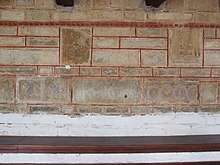Makrinitissa Monastery
The Makrinitissa Monastery (Greek: Μονή Μακρινιντίσσης) was a male Greek Orthodox monastery at Makrinitsa, near Volos, Thessaly, in central Greece.
History
The monastery was founded by the Thessalian magnate Constantine Maliasenos from Demetrias some time before 1215 on Mount Drongos in the district of Dryanoubaina, and dedicated to the Theotokos "of the Swift Visitation" (τῆς Ὀξείας Ὲπισκέψεως).[1] As the monastery is recorded as possessing the metochion of Hilarion at Halmyros granted by a certain "Conte", identified by some scholars with William of Champlitte, Prince of Achaea between 1205–1209, the monastery's foundation is usually placed during this time frame.[2] "Conte" may however also be identified with Count Berthold II von Katzenelnbogen, lord of Velestino.[3]
The monastery is first attested in a document issued by Arsenios, the Bishop of Demetrias, in 1215, confirming its status as stauropegic (directly subject to the Patriarchate of Constantinople).[1][3] Nevertheless, a subsequent charters make clear, Arsenios' successors did not cease to attempt to subordinate the monastery to their see, forcing successive patriarchs to issue statements in defence of the monastery's status: Germanos II between 1233–1240, Manuel II between 1243–1254, and finally Arsenios Autoreianos in 1256, following a petition of Nicholas Maliasenos, son of the monastery's founder.[3][4]
Both Constantine Maliasenos and his son became monks, with the monastic name of Konstantios and Joasaph respectively, at the monastery in later life, and died and were buried there.[5] According to a document issued by Emperor Michael VIII Palaiologos in 1274, the monastery, along with the nearby female convent of Nea Petra (founded by Nicholas and his wife Anna, a niece of Michael VIII, in 1271/72) at Portaria, were to pass to Nicholas' son John Maliasenos Palaiologos after his parents' death.[6][7] John apparently engaged in large-scale reconstruction at the monastery, where he too lived out his life as the monk Neilos, since in his funeral inscription he is mentioned as the monastery's "second founder".[8]

Following its heyday in the 13th century, the historical sources are completely silent about the monastery during the 14th–17th centuries.[9] Sometime after 1700, the monastery, possibly including the main church (katholikon) suffered considerable damage due to landslides.[9] In 1743, the two-storey chapel of St. Bicholas and All Saints southwest of the katholikon was rebuilt.[9]
The masonry of the ruined katholikon, and part of its decoration—notably a relief of the Theotokos Oxeia Episkepsis—were reused in the Church of the Dormition of the Theotokos which was erected in 1767 in its place.[6][9][10] Fragments of the tombs of the Maliasenoi are spread across other churches in the region.[11]
Possessions
The monastery gathered considerable possessions, which had to be repeatedly confirmed in a series of deeds.[3][12] Thus the monastery of Hilarion at Halmyros was granted to the monastery as a metochion, but later removed by the Latin rulers of Thessaly, before being restored to the Makrinitissa Monastery by Michael II of Epirus.[13] It was reconfirmed as a possession of Makrinitissa by Arsenios Autoreianos, although he also recognized the canonical rights of the Bishop of Velestino over it.[14] However, it appears that the Maliasenoi fell out with the rulers of Epirus, as the Hilarion monastery was removed again from the possession of Makrinitissa, and was only restored to it by Michael VIII's brother John Palaiologos when he captured Thessaly from Epirus in 1260.[15]
References
- Giannopoulos 1924, p. 210.
- Giannopoulos 1924, p. 211.
- Koder & Hild 1976, p. 210.
- Giannopoulos 1924, pp. 212–214.
- Giannopoulos 1924, p. 214.
- Koder & Hild 1976, p. 211.
- Anastasiadou & Kontogiannopoulou 2009, p. 525.
- Anastasiadou & Kontogiannopoulou 2009, pp. 525–529.
- ""Μονή Θεομήτορος της Οξείας Επισκέψεως της Μακρινιτίσσης" Ιστορική Χρονογραμμή" (in Greek). Byzantine Museum of Makrinitsa. Retrieved 25 July 2019.
- Anastasiadou & Kontogiannopoulou 2009, pp. 525–526.
- Anastasiadou & Kontogiannopoulou 2009, pp. 529–532.
- For a list of the possessions and relevant literature, see Giannopoulos 1924, pp. 215–222 and Koder & Hild 1976, pp. 210–211.
- Giannopoulos 1924, pp. 211–212.
- Giannopoulos 1924, pp. 213–214.
- Giannopoulos 1924, pp. 214–215.
Sources
- Anastasiadou, Archontoula; Kontogiannopoulou, Maria (2009). "Το επιτύμβιο επίγραμμα ενός Παλαιολόγου στη Μακρινίτσα του Πηλίου και η σχέση του με τα ταφικά μνημεία των Μαλιασηνών της Μαγνησίας". Αρχαιολογικό Έργο Θεσσαλίας και Στερεάς Ελλάδας 2, 2006. Πρακτικά επιστημονικής συνάντησηςΒόλος 16.3 – 19.3.2006. Τόμος I: Θεσσαλία. Volos. pp. 525–537. ISBN 978-960-89078-3-6.CS1 maint: ref=harv (link)
- Giannopoulos, N. I. (1924). "Αι παρά την Δημητριάδα Βυζαντιναί μοναί". Ἐπετηρίς Ἐταιρείας Βυζαντινῶν Σπουδῶν (in Greek). 1: 210–240.CS1 maint: ref=harv (link)
- Koder, Johannes; Hild, Friedrich (1976). Tabula Imperii Byzantini, Band 1: Hellas und Thessalia (in German). Vienna: Verlag der Österreichischen Akademie der Wissenschaften. ISBN 978-3-7001-0182-6.